2010美国自发性脑出血处理指南
- 格式:ppt
- 大小:2.95 MB
- 文档页数:57
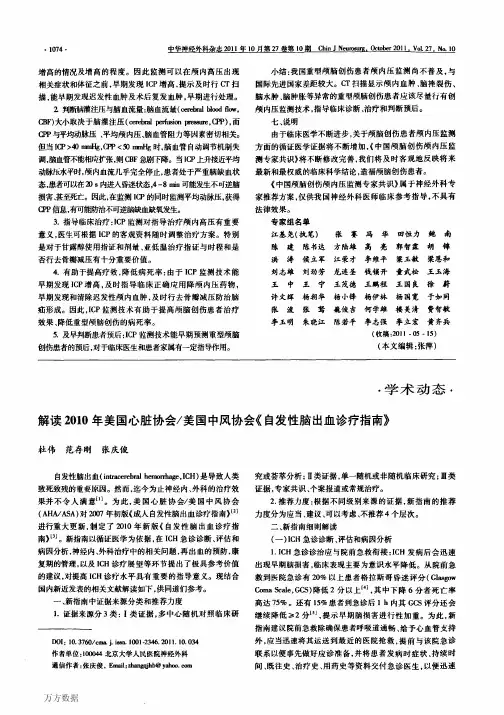
2011-05-15解读2010年美国心脏协会/美国中风协会《自发性脑出血诊疗指南》杜伟范存刚张庆俊 自发性脑出血(intracerebral hemorrhage, ICH)是导致人类致死致残的重要原因。
然而,迄今为止神经内、外科的治疗效果并不令人满意[1]。
为此,美国心脏协会/美国中风协会(AHA/ASA)对2007年初版《成人自发性脑出血诊疗指南》[2]进行重大更新,制定了2010年新版《自发性脑出血诊疗指南》[3]。
新指南以循证医学为依据,在ICH急诊诊断、评估和病因分析,神经内、外科治疗中的相关问题,再出血的预防,康复期的管理,以及ICH诊疗展望等环节提出了极具参考价值的建议,对提高ICH诊疗水平具有重要的指导意义。
现结合国内新近发表的相关文献解读如下,供同道们参考。
10. 3760/cma. j. issn. 1001-2346. 2011. 10. 034100044 北京大学人民医院神经外科万方数据・1075・万方数据@@[1]赵继宗,周定标,周良辅,等.2464例高血压脑出血外科治 疗多中心单盲研究.中华医学杂志,2005, 85: 2238-2242.@@[2] Broderick J, Connolly S, Feldmann E, et al. Guidelines for the management of spontaneous intracerebral hemorrhage in adults: 2007 update; a guideline from the American Heart Association/ American Stroke Association Stroke Council, High Blood Pressure Research Council, and the Quality of Care and Outcomes in Research Interdisciplinary Working Group. Stroke, 2007, 38: 2001-2023. @@[3] Morgenstern LB, Hemphill JC 3rd, Anderson C, et al. Guid elines for the management of spontaneous intracerebral hemorrhage: a guideline for healthcare professionals from the American Heart Association/American Stroke Association. Stroke,2010, 41 : 2108-2129. @@[4] Moon JS, Janjua N, Ahmed S, et al. Prehospital neurologic de terioration in patients with intracerebral hemorrhage. Crit Care Med, 2008, 36: 172-175. @@[5] Brott T, Broderick J, Kothari R, et al. Early hemorrhage growth in patients with intracerebral hemorrhage. Stroke, 1997, 28 : 1-5. @@[6] Flaherty ML, Kissela B, Woo D, et al. The increasing incidence of anticoagulant-associated intracerebral hemorrhage. Neurology, 2007, 68:116-121.@@ [ 7 ] Leissinger CA, Blatt PM, Hoots WK, et al. Role of prothrombin complex concentrates in reversing warfarin anticoagulation: a review of the literature. Am J Hematol, 2008, 83:137-143. @@[ 8 ] CLOTS Trials Collaboration, Dennis M, Sandercock PA, et al. Effectiveness of thigh-length graduated compression stockings to reduce the risk of deep vein thrombosis after stroke( CLOTS trial 1 ): a multicentre, randomised controlled trial. Lancet, 2009, 373 : 1958-1965. @@[9] Lacut K, Bressollette L, Le Gal G, et al. Prevention of venous thrombosis in patients with acute intracerebral hemorrhage. Neurology, 2005, 65:865-869.@@[ 10] Boeer A, Voth E, Henze T, et al. Early heparin therapy in patients with spontaneous intracerebral haemorrhage. J Neurol Neurosurg Psychiatry, 1991,54:466-467.@@[ 11 ] Messé SR, Sansing LH, Cucchiara BL, et al. Prophylactic an tiepileptic drug use is associated with poor outcome following ICH. Neurocrit Care, 2009, 11:38-44.@@[ 12] Huttner HB, K(o)hrmann M, Berger C, et al. Influence of intr aventricular hemorrhage and occlusive hydrocephalus on the long term outcome of treated patients with basal ganglia hemorrhage:a case-control study. J Neurosurg, 2006, 105:412- 417.@@[13] Morgan T, Awad I, Keyl P, et al. Preliminary report oftheclot lysis evaluating accelerated resolution of intraventricular hemorrhage( CLEAR-IVH ) clinical trial. Acta Neurochir Suppl, 2008, 105:217-220.@@[ 14] Pantazis G, Tsitsopoulos P, Mihas C, et al. Early surgical tre atment vs conservative management for spontaneous supratentorial intracerebral hematomas: A prospective randomized study. Surg Neurol, 2006, 66 : 492-501 ;discussion 501-502.@@[ 15 ] Mendelow AD, Gregson BA, Femandes HM, et al. Early surgery versus initial conservative treatment in patients with spontaneous supratentorial intracerebral haematomas in the International Surgical Trial in Intracerebral Haemorrhage (STICH): a randomised trial. Lancet ,2005, 365:387-397.@@[ 16 ] Rost NS, Smith EE, Chang Y, et al. Prediction of functional outcome in patients with primary intracerebral hemorrhage: the FUNC score. Stroke, 2008, 39:2304-2309.@@[17] 彭化生,袁春兰.老年脑出血患者康复介入时间不同对功能 恢复影响的对照研究.中华神经医学杂志,2006,5: 1026-1028.@@[18]刘兆平,曾满萍.社区康复对脑出血偏瘫患者整体功能和生 活质量的影响.卒中与神经疾病,2010,17:39-42.2010-12-142011-03-10万方数据解读2010年美国心脏协会/美国中风协会《自发性脑出血诊疗指南》作者:杜伟, 范存刚, 张庆俊作者单位:100044,北京大学人民医院神经外科刊名:中华神经外科杂志英文刊名:Chinese Journal of Neurosurgery年,卷(期):2011,27(10)本文链接:/Periodical_zhsjwkzz98201110034.aspx。
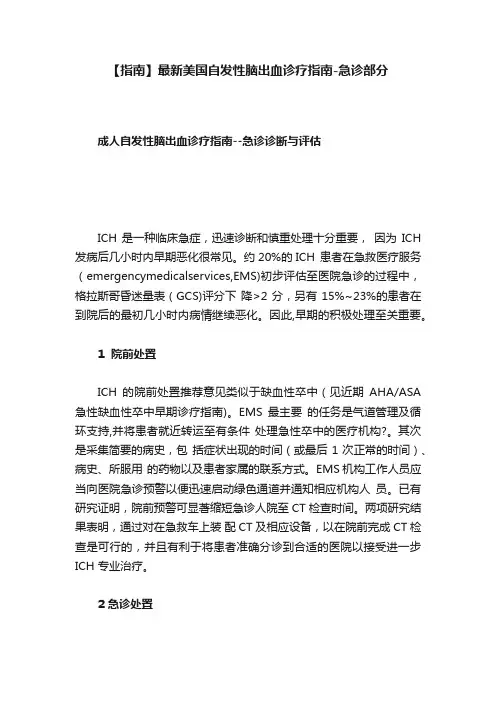
【指南】最新美国自发性脑出血诊疗指南-急诊部分成人自发性脑出血诊疗指南--急诊诊断与评估ICH是一种临床急症,迅速诊断和慎重处理十分重要,因为ICH 发病后几小时内早期恶化很常见。
约20%的ICH 患者在急救医疗服务(emergencymedicalservices,EMS)初步评估至医院急诊的过程中,格拉斯哥昏迷量表(GCS)评分下降>2分,另有15%~23%的患者在到院后的最初几小时内病情继续恶化。
因此,早期的积极处理至关重要。
1 院前处置ICH的院前处置推荐意见类似于缺血性卒中(见近期AHA/ASA 急性缺血性卒中早期诊疗指南)。
EMS最主要的任务是气道管理及循环支持,并将患者就近转运至有条件处理急性卒中的医疗机构?。
其次是采集简要的病史,包括症状出现的时间(或最后1次正常的时间)、病史、所服用的药物以及患者家属的联系方式。
EMS机构工作人员应当向医院急诊预警以便迅速启动绿色通道并通知相应机构人员。
已有研究证明,院前预警可显著缩短急诊人院至CT 检查时间。
两项研究结果表明,通过对在急救车上装配CT及相应设备,以在院前完成CT检查是可行的,并且有利于将患者准确分诊到合适的医院以接受进一步ICH 专业治疗。
2 急诊处置急诊应当具备处理ICH患者的能力或具有迅速转运至三级医院的方案。
处理ICH患者必须具备神经科、神经放射科、神经外科、急诊等机构及相应的训练有素的医护人员。
患者到达急诊后,应当由医师与护士尽快接诊或会诊,并进行简短而高效的临床评估。
对于无条件进行院内会诊的机构,通过远程医疗进行会诊也是一种有效的手段。
ICH评估应当包括标准化严重程度评分,以利于连续的评估及医务人员间的交流。
美国国立卫生研究院卒中量表(NIHSS)常用于缺血性卒中,在ICH患者中也可能有效。
但ICH患者就诊时通常伴有意识障碍,可能使 NIHSS评分的准确性受限。
对于ICH的评估,也有很多专用的量表,但何种量表最为准确,尚存争议。
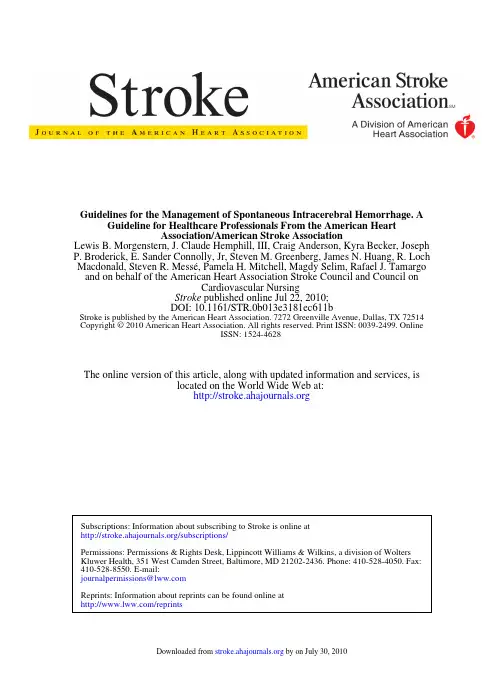
ISSN: 1524-4628Copyright © 2010 American Heart Association. All rights reserved. Print ISSN: 0039-2499. OnlineStroke is published by the American Heart Association. 7272 Greenville Avenue, Dallas, TX 72514DOI: 10.1161/STR.0b013e3181ec611bpublished online Jul 22, 2010; Stroke Cardiovascular Nursingand on behalf of the American Heart Association Stroke Council and Council onMacdonald, Steven R. Messé, Pamela H. Mitchell, Magdy Selim, Rafael J. Tamargo Loch P. Broderick, E. Sander Connolly, Jr, Steven M. Greenberg, James N. Huang, R. Lewis B. Morgenstern, J. Claude Hemphill, III, Craig Anderson, Kyra Becker, JosephAssociation/American Stroke Association Guideline for Healthcare Professionals From the American HeartGuidelines for the Management of Spontaneous Intracerebral Hemorrhage. A located on the World Wide Web at:The online version of this article, along with updated information and services, is/reprints Reprints: Information about reprints can be found online atjournalpermissions@ 410-528-8550. E-mail:Fax:Kluwer Health, 351 West Camden Street, Baltimore, MD 21202-2436. Phone: 410-528-4050. Permissions: Permissions & Rights Desk, Lippincott Williams & Wilkins, a division of Wolters/subscriptions/Subscriptions: Information about subscribing to Stroke is online atGuidelines for the Management of SpontaneousIntracerebral HemorrhageA Guideline for Healthcare Professionals From the American HeartAssociation/American Stroke AssociationThe American Academy of Neurology affirms the value of this guideline as an educationaltool for neurologists.The American Association of Neurological Surgeons and the Congress of Neurological Surgeons have reviewed this document and affirm its educational content.Lewis B.Morgenstern,MD,FAHA,FAAN,Chair;J.Claude Hemphill III,MD,MAS,FAAN,Vice-Chair;Craig Anderson,MBBS,PhD,FRACP;Kyra Becker,MD;Joseph P.Broderick,MD,FAHA;E.Sander Connolly,Jr,MD,FAHA; Steven M.Greenberg,MD,PhD,FAHA,FAAN;James N.Huang,MD;R.Loch Macdonald,MD,PhD;Steven R.Messé,MD,FAHA;Pamela H.Mitchell,RN,PhD,FAHA,FAAN;Magdy Selim,MD,PhD,FAHA;Rafael J.Tamargo,MD;on behalf of the American Heart AssociationStroke Council and Council on Cardiovascular NursingPurpose—The aim of this guideline is to present current and comprehensive recommendations for the diagnosis and treatment of acute spontaneous intracerebral hemorrhage.Methods—A formal literature search of MEDLINE was performed.Data were synthesized with the use of evidence tables.Writing committee members met by teleconference to discuss data-derived recommendations.The American Heart Association Stroke Council’s Levels of Evidence grading algorithm was used to grade each recommendation.Prerelease review of the draft guideline was performed by6expert peer reviewers and by the members of the Stroke Council Scientific Statements Oversight Committee and Stroke Council Leadership Committee.It is intended that this guideline be fully updated in3years’time.Results—Evidence-based guidelines are presented for the care of patients presenting with intracerebral hemorrhage.The focus was subdivided into diagnosis,hemostasis,blood pressure management,inpatient and nursing management, preventing medical comorbidities,surgical treatment,outcome prediction,rehabilitation,prevention of recurrence,and future considerations.Conclusions—Intracerebral hemorrhage is a serious medical condition for which outcome can be impacted by early, aggressive care.The guidelines offer a framework for goal-directed treatment of the patient with intracerebral hemorrhage.(Stroke.2010;41:00-00.)Key Words:AHA Scientific StatementsⅢintracerebral hemorrhageⅢtreatmentⅢdiagnosisⅢintracranial pressureⅢhydrocephalusⅢsurgeryThe American Heart Association makes every effort to avoid any actual or potential conflicts of interest that may arise as a result of an outside relationship or a personal,professional,or business interest of a member of the writing panel.Specifically,all members of the writing group are required to complete and submit a Disclosure Questionnaire showing all such relationships that might be perceived as real or potential conflicts of interest. This statement was approved by the American Heart Association Science Advisory and Coordinating Committee on May19,2010.A copy of the statement is available at /presenter.jhtml?identifierϭ3003999by selecting either the“topic list”link or the“chronological list”link(No.KB-0044).To purchase additional reprints,call843-216-2533or e-mail kelle.ramsay@.The American Heart Association requests that this document be cited as follows:Morgenstern LB,Hemphill JC3rd,Anderson C,Becker K,Broderick JP,Connolly ES Jr,Greenberg SM,Huang JN,Macdonald RL,MesséSR,Mitchell PH,Selim M,Tamargo RJ;on behalf of the American Heart Association Stroke Council and Council on Cardiovascular Nursing.Guidelines for the management of spontaneous intracerebral hemorrhage:a guideline for healthcare professionals from the American Heart Association/American Stroke Association.Stroke.2010;41:●●●–●●●.Expert peer review of AHA Scientific Statements is conducted at the AHA National Center.For more on AHA statements and guidelines development, visit /presenter.jhtml?identifierϭ3023366.Permissions:Multiple copies,modification,alteration,enhancement,and/or distribution of this document are not permitted without the express permission of the American Heart Association.Instructions for obtaining permission are located at /presenter.jhtml? identifierϭ4431.A link to the“Permission Request Form”appears on the right side of the page.©2010American Heart Association,Inc.Stroke is available at DOI:10.1161/STR.0b013e3181ec611bS pontaneous,nontraumatic intracerebral hemorrhage(ICH) is a significant cause of morbidity and mortality throughout the world.Although much has been made of the lack of a specific targeted therapy,much less is written about the success and goals of aggressive medical and surgical care for this disease.Recent population-based studies suggest that most patients present with small ICHs that are readily survivable with good medical care.1This suggests that excellent medical care likely has a potent,direct impact on ICH morbidity and mortality now,even before a specific therapy is found.Indeed,as discussed later,the overall aggressiveness of ICH care is directly related to mortality from this disease.2One of the purposes of this guideline,therefore,is to remind clinicians of the impor-tance of their care in determining ICH outcome and to provide an evidence-based framework for that care.In order to make this review brief and readily useful to practicing clinicians,the reader is referred elsewhere for the details of ICH epidemiology.1,3,4Similarly,there are many ongoing clinical studies throughout the world related to this disease.The reader is encouraged to consider referring patients to these important efforts,which can be found at /trials/.We will not discuss on-going studies because we cannot cover them all;the focus of this statement is on currently available therapies.Finally,a recent guideline on pediatric stroke was published5that obviates the need to repeat the issues of pediatric ICH here. The last ICH Guidelines were published in2007,6and this current article serves to update those guidelines.As such, differences from former recommendations are specified in the current work.The writing group met by phone to determine subcategories to evaluate.These included emergency diagnosis and assessment of ICH and its causes;hemostasis,blood pressure(BP);intracranial pressure(ICP)/fever/glucose/ seizures/hydrocephalus;iron;ICP monitors/tissue oxygenation; clot removal;intraventricular hemorrhage(IVH);withdrawal of technological support;prevention of recurrent ICH;nursing care;rehab/recovery;future considerations.Each subcategory was led by an author with1or2additional authors making contributions.Full MEDLINE searches were done of all English-language articles regarding relevant human disease treatment.Drafts of summaries and recommendations were circulated to the whole writing group for feedback.A conference call was held to discuss controversial issues.Sections were revised and merged by the Chair.The resulting draft was sent to the whole writing group for ments were incor-porated by the Vice Chair and Chair,and the entire committee was asked to approve the final draft.Changes to the document were made by the Chair and Vice Chair in response to peer review,and the document was again sent to the entire writing group for suggested changes and approval.Recommendations follow the American Heart Association Stroke Council’s methods of classifying the level of certainty of the treatment effect and the class of evidence(Tables1and2).All Class I recommendations are listed in Table3.Emergency Diagnosis and Assessment of ICHand Its CausesICH is a medical emergency.Rapid diagnosis and attentive management of patients with ICH is crucial because early deterioration is common in the first few hours after ICH onset.More than20%of patients will experience a decrease in the Glasgow Coma Scale(GCS)score ofՆ2points between the prehospital emergency medical services assess-ment and the initial evaluation in the emergency department (ED).7Among those patients with prehospital neurological decline,the GCS score decreases by an average of6points and the mortality rate isϾ75%.Further,within the first hour of presentation to a hospital,15%of patients demonstrate a decrease in the GCS score ofՆ2points.8The risk for early neurological deterioration and the high rate of poor long-term outcomes underscores the need for aggressive early management.Prehospital ManagementThe primary objective in the prehospital setting is to provide ventilatory and cardiovascular support and to transport the patient to the closest facility prepared to care for patients with acute stroke (see ED Management section that follows).Secondary priorities for emergency medical services providers include obtaining a focused history regarding the timing of symptom onset(or the time the patient was last normal)and information about medical history, medication,and drug use.Finally,emergency medical services providers should provide advance notice to the ED of the impending arrival of a potential stroke patient so that critical pathways can be initiated and consulting services can be alerted.Advance notice by emergency medical services has been demonstrated to significantly shorten time to computed tomography(CT)scanning in the ED.9 ED ManagementIt is of the utmost importance that every ED be prepared to treat patients with ICH or have a plan for rapid transfer to a tertiary care center.The crucial resources necessary to man-age patients with ICH include neurology,neuroradiology, neurosurgery,and critical care facilities including adequately trained nurses and physicians.In the ED,appropriate consul-tative services should be contacted as quickly as possible and the clinical evaluation should be performed efficiently,with physicians and nurses working in parallel.Table4describes the integral components of the history,physical examination, and diagnostic studies that should be obtained in the ED. For patients with ICH,emergency management may in-clude neurosurgical interventions for hematoma evacuation, external ventricular drainage or invasive monitoring and treatment of ICP,BP management,intubation,and reversal of coagulopathy.Although many centers have critical pathways developed for the treatment of acute ischemic stroke,few have protocols for the management of ICH.18Such pathways may allow for more efficient,standardized,and integrated management of critically ill patients with ICH. NeuroimagingThe abrupt onset of focal neurological symptoms is presumed to be vascular in origin until proven otherwise.However,it is impossible to know whether symptoms are due to ischemia or hemorrhage based on clinical characteristics alone.Vomiting, systolic BPϾ220mm Hg,severe headache,coma or decreased level of consciousness,and progression over minutes or hours all suggest ICH,although none of these findings are specific;2Stroke September2010neuroimaging is thus mandatory.19CT and magnetic resonance imaging(MRI)are both reasonable for initial evaluation.CT is very sensitive for identifying acute hemorrhage and is consid-ered the gold standard;gradient echo and T2*susceptibility-weighted MRI are as sensitive as CT for detection of acute blood and are more sensitive for identification of prior hemorrhage.20,21 Time,cost,proximity to the ED,patient tolerance,clinical status, and MRI availability may,however,preclude emergent MRI in a sizeable proportion of cases.22The high rate of early neurological deterioration after ICH is in part related to active bleeding that may proceed for hours after symptom onset.The earlier time from symptom onset to first neuroimage,the more likely subsequent neuroimages will demonstrate hematoma expansion.15,23,24Among patients undergoing head CT within3hours of ICH onset,28%to 38%have hematoma expansion of greater than one third on follow-up CT.8,25Hematoma expansion is predictive of clinical deterioration and increased morbidity and mortali-ty.8,10,15,25As such,identifying patients at risk for hematoma expansion is an active area of research.CT angiography and contrast-enhanced CT may identify patients at high risk of ICH expansion based on the presence of contrast extravasa-tion within the hematoma.26–30MRI/angiogram/venogram and CT angiogram/venogram are reasonably sensitive at identifying secondary causes of hemorrhage,including arte-riovenous malformations,tumors,moyamoya,and cerebral vein thrombosis.31–33A catheter angiogram may be consid-ered if clinical suspicion is high or noninvasive studies are suggestive of an underlying vascular cause.Clinical suspicion of a secondary cause of ICH may include a prodrome of headache,neurological,or constitutional symptoms.Radio-logical suspicions of secondary causes of ICH should beTable1.Applying Classification of Recommendations and Level ofEvidence*Data available from clinical trials or registries about the usefulness/efficacy in different subpopulations,such as sex,age,history of diabetes,history of prior myocardial infarction,history of heart failure,and prior aspirin use.A recommendation with Level of Evidence B or C does not imply that the recommendation is weak. Many important clinical questions addressed in the guidelines do not lend themselves to clinical trials.Even though randomized trials are not available,there may be a very clear clinical consensus that a particular test or therapy is useful or effective.†In2003,the ACCF/AHA Task Force on Practice Guidelines developed a list of suggested phrases to use when writing recommendations.All guideline recommendations have been written in full sentences that express a complete thought,such that a recommendation,even if separated and presented apart from the rest of the document(including headings above sets of recommendations),would still convey the full intent of the recommendation.It is hoped that this will increase readers’comprehension of the guidelines and will allow queries at the individual recommendation level.Morgenstern et al Intracerebral Hemorrhage Guideline3invoked by the presence of subarachnoid hemorrhage,un-usual(noncircular)hematoma shape,the presence of edema out of proportion to the early time an ICH is first imaged,an unusual location for hemorrhage,and the presence of other abnormal structures in the brain like a mass.An MR or CT venogram should be performed if hemorrhage location,rela-tive edema volume,or abnormal signal in the cerebral sinuses on routine neuroimaging suggest cerebral vein thrombosis. In summary,ICH is a medical emergency,characterized by high morbidity and mortality,which should be promptly diagnosed and aggressively managed.Hematoma expansion and early deteriora-tion are common within the first few hours after onset. Recommendations1.Rapid neuroimaging with CT or MRI is recommendedto distinguish ischemic stroke from ICH(Class I;Level of Evidence:A).(Unchanged from the previous guideline) 2.CT angiography and contrast-enhanced CT may beconsidered to help identify patients at risk for hema-toma expansion(Class IIb;Level of Evidence:B),and CT angiography,CT venography,contrast-enhanced CT,contrast-enhanced MRI,magnetic resonance an-giography,and magnetic resonance venography can beuseful to evaluate for underlying structural lesions, including vascular malformations and tumors when there is clinical or radiological suspicion(Class IIa;Level of Evidence:B).(New recommendation)Medical Treatment for ICH Hemostasis/Antiplatelets/Deep VeinThrombosis ProphylaxisUnderlying hemostatic abnormalities can contribute to ICH. Patients at risk include those on oral anticoagulants(OACs), those with acquired or congenital coagulation factor deficien-cies,and those with qualitative or quantitative platelet abnormal-ities.Patients undergoing treatment with OACs constitute12% to14%of patients with ICH,34,35and with increased use of warfarin,the proportion appears to be increasing.36Recognition of an underlying coagulopathy thus provides an opportunity to target correction in the treatment strategy.For patients with a coagulation factor deficiency and thrombocytopenia,replace-ment of the appropriate factor or platelets is indicated.For patients being treated with OACs who have life-threatening bleeding,such as intracranial hemorrhage,the general recommen-dation is to correct the international normalized ratio(INR)as rapidly as possible.37,38Infusions of vitamin K and fresh-frozen plasma(FFP)have historically been recommended,but more recently,prothrombin complex concentrates(PCCs)and recom-binant factor VIIa(rFVIIa)have emerged as potential therapies. Vitamin K remains an adjunct to more rapidly acting initial therapy for life-threatening OAC-associated hemorrhage be-cause even when given intravenously,it requires hours to correct the INR.39–41The efficacy of FFP is limited by risk of allergic and infectious transfusion reactions,processing time,and the volume required for correction.Likelihood of INR correction at 24hours was linked to time to FFP administration in1study, although17%of patients still did not have an INRՅ1.4at this time,suggesting that FFP administered in this manner may be insufficient for rapid correction of coagulopathy.42PCCs are plasma-derived factor concentrates primarily used to treat factor IX deficiency.Because PCCs also contain factors II,VII,and X in addition to IX,they are increasingly recommended for warfarin reversal.PCCs have the advan-tages of rapid reconstitution and administration,having high concentrations of coagulation factors in small volumes,and processing to inactivate infectious agents.Though different PCC preparations differ in relative amounts of factors(with VII the most likely to be low),several studies have shown that PCCs can rapidly normalize INR(within minutes)in patients taking OACs(reviewed in43–45).Nonrandomized retrospective reviews and a small case-control study have shown more rapid correction of INR with vitamin K and PCC than vitamin K and FFP,but have not revealed a difference in clinical outcome.46–48One randomized trial compared the use of a PCC(Konyne)to supplement FFP versus FFP alone in patients with OAC-related ICH,finding that those who received PCC had significantly shorter time to INR correction and received less volume of FFP.Although there was no difference in outcome,those who received FFP also had more adverse events,primarily attributable to fluid overload.49 Although PCCs may theoretically increase the risk of throm-botic complications,this risk appears relatively low.43De-Table2.Definition of Classes and Levels of Evidence Used in American Heart Association Stroke Council Recommendations Class I Conditions for which there is evidence forand/or general agreement that theprocedure or treatment is useful andeffectiveClass II Conditions for which there is conflictingevidence and/or a divergence ofopinion about the usefulness/efficacyof a procedure or treatmentClass IIa The weight of evidence or opinion is infavor of the procedure or treatment Class IIb Usefulness/efficacy is less wellestablished by evidence or opinion Class III Conditions for which there is evidenceand/or general agreement that theprocedure or treatment is notuseful/effective and in some casesmay be harmfulTherapeutic recommendationsLevel of Evidence A Data derived from multiple randomizedclinical trials or meta-analysesLevel of Evidence B Data derived from a single randomizedtrial or nonrandomized studiesLevel of Evidence C Consensus opinion of experts,casestudies,or standard of care Diagnostic recommendationsLevel of Evidence A Data derived from multiple prospectivecohort studies using a referencestandard applied by a maskedevaluatorLevel of Evidence B Data derived from a single grade A study,or one or more case-control studies,orstudies using a reference standardapplied by an unmasked evaluator Level of Evidence C Consensus opinion of experts4Stroke September2010spite the lack of large,well-controlled,randomized trials, PCCs are being increasingly recommended as an option in guidelines promulgated for warfarin reversal in the setting of OAC-associated life-threatening or intracranial hemor-rhages.37,38,50–52Table5provides a list of several products for factor replacement in warfarin reversal that are commer-cially available in the United States at the present time. rFVIIa,licensed to treat hemophilia patients with high titer inhibitors or congenital factor VII deficiency,has garnered attention as a potential treatment for spontaneous and OAC-associated ICH.Although rFVIIa can rapidly normalize INR in the setting of OAC-associated ICH,53–57it does not replenish all of the vitamin K–dependent factors and there-fore may not restore thrombin generation as well as PCCs.58 In light of the limited data,a recent American Society of Hematology evidence-based review recommended against routine use of rFVIIa for warfarin reversal.59rFVIIa has also been tested in patients with non-OAC ICH.A phase2randomized trial showed that treatment with rFVIIa within4hours after ICH onset limited hematoma growth and improved clinical outcomes relative to placebo, though with increased frequency of thromboembolic events (7%versus2%).60A subsequent phase3study comparing placebo with20g/kg and80g/kg of rFVIIa failed to show differences in clinical outcome,despite confirming the ability of both doses to diminish hematoma enlargement.61Although overall serious thromboembolic adverse events were similar, the higher rFVIIa(80g/kg)group had significantly more arterial events than the placebo group.The authors noted imbalances in the treatment groups,particularly the greater number of patients with IVH in the higher-dose rFVIIa group.60It remains to be determined whether rFVIIa will benefit a particular subset of patients with ICH,but currently its benefits in ICH patients,whether or not they are under-going treatment with OACs,remain unproven.Studies of the effect of prior antiplatelet agent use or platelet dysfunction on ICH hematoma growth and outcome have found conflicting results.Reported antiplatelet agent use was not associated with hematoma expansion or clinical outcome in the placebo group of an ICH neuroprotective study.62However,others have suggested that platelet dys-function as measured by platelet function assays may be associated with hematoma expansion and clinical out-come.63,64The utility and safety of platelet transfusion orTable3.Class I RecommendationsRecommendations Class/Level of EvidenceEmergency diagnosis and assessment of ICH and its causes Rapid neuroimaging with CT or MRI is recommended to distinguishischemic stroke from ICH.(Unchanged from the previousguideline)Class I,Level AMedical treatment for ICH Patients with a severe coagulation factor deficiency or severethrombocytopenia should receive appropriate factor replacementtherapy or platelets,respectively.(New recommendation)Class I,Level CHemostasis/antiplatelets/DVT prophylaxis Patients with ICH whose INR is elevated due to OAC should havetheir warfarin withheld,receive therapy to replace vitaminK–dependent factors and correct the INR,and receiveintravenous vitamin K.(Revised from the previous guideline)Class I,Level CPatients with ICH should have intermittent pneumatic compressionfor prevention of venous thromboembolism in addition to elasticstockings.(Unchanged from the previous guideline)Class I,Level BInpatient management and prevention ofsecondary brain injuryGeneral monitoring Initial monitoring and management of ICH patients should takeplace in an intensive care unit,preferably one with physicianand nursing neuroscience intensive care expertise.(Unchangedfrom the previous guideline)Class I,Level B Management of glucose Glucose should be monitored and normoglycemia is recommended Class I,Level CSeizures and antiepileptic drugs Patients with clinical seizures should be treated with antiepilepticdrugs.(Revised from previous guideline)Patients with a change in mental status who are found to haveelectrographic seizures on EEG should be treated withantiepileptic drugs Class I,Level A Class I,Level CProcedures/surgery—clot removal Patients with cerebellar hemorrhage who are deterioratingneurologically or who have brainstem compression and/orhydrocephalus from ventricular obstruction should undergosurgical removal of the hemorrhage as soon as possible.(Revised from the previous guideline)Class I,Level BPrevention of recurrent ICH After the acute ICH,absent medical contraindications,BP shouldbe well controlled,particularly for patients with ICH locationtypical of hypertensive vasculopathy.(New recommendation)Class I,Level ACT indicates computed tomography;MRI,magnetic resonance imaging;DVT,deep vein thrombosis;INR,international normalized ratio;OAC,oral anticoagulants; and EEG,electroencephalogram.Morgenstern et al Intracerebral Hemorrhage Guideline5other agents in patients with a normal platelet count,but use of antiplatelet agents or platelet dysfunction,is not known.Patients with ICH have a high risk of thromboembolic disease.65Women and African Americans appear to be at greater risk.65–67Intermittent pneumatic compression combined with elastic stockings has been shown by a randomized trial to be superior to elastic stockings alone in reducing occurrence of asymptomatic deep vein thrombosis after ICH (4.7%versus 15.9%).68Graduated compression stockings alone are ineffec-tive in preventing deep vein thrombosis.69Less clear,however,is the role of adding anticoagulation to pneumatic compression.Two small randomized studies found no difference in deep vein throm-bosis incidence,and no increase in bleeding,in patients given low-dose subcutaneous heparin initiated at day 4or at day 10after ICH.70,71An uncontrolled study of treatment initiated on day 2found a reduction in thromboembolic disease without increased rebleeding.70Recommendations1.Patients with a severe coagulation factor deficiency or severe thrombocytopenia should receive appropriate fac-tor replacement therapy or platelets,respectively (Class I;Level of Evidence:C).(New recommendation)2.Patients with ICH whose INR is elevated due to OACs should have their warfarin withheld,receive therapy to replace vitamin K–dependent factors and correct the INR,and receive intravenous vitamin K (Class I;Level of Evidence:C).PCCs have not shown improved outcome compared with FFP but may have fewer complications compared with FFP and are reasonable to consider as an alternative to FFP (Class IIa;Level of Evidence:B).rFVIIa does not replace all clotting factors,and although the INR may be lowered,clotting may not be restored in vivo;therefore,rFVIIa is not routinely recommended as a sole agent for OAC re-versal in ICH (Class III;Level of Evidence:C).(Revised from the previous guideline).3.Although rFVIIa can limit the extent of hematoma expansion in noncoagulopathic ICH patients,thereTable 4.Integral Components of the History,PhysicalExamination,and Work-Up of the Patient With ICH in the EDCommentsHistoryTime of symptom onset (or time the patient was last normal)Initial symptoms and progression of symptoms Vascular risk factors Hypertension,diabetes,hypercholesterolemia,and smoking MedicationsAnticoagulants,antiplatelet agents,decongestants,antihypertensivemedications,stimulants (including diet pills),sympathomimeticsRecent trauma or surgeryCarotid endarterectomy or carotid stenting in particular,as ICH may be related to hyperperfusion after such procedures DementiaAssociated with amyloid angiopathy Alcohol or illicit drug useCocaine and other sympathomimetic drugs are associated with ICH,stimulants Seizures Liver diseaseMay be associated with coagulopathy Cancer and hematologic disorders May be associated with coagulopathyPhysical examination Vital signsFever is associated with early neurologic deterioration 10Higher initial blood pressure is associated with early neurologic deterioration and increased mortality 11A general physicalexamination focusing on the head,heart,lungs,abdomen,and extremities A thorough but time-urgent neurologic examinationA structured examination such as the National Institutes of Health Stroke Scale can be completed in minutes and provides a quantification that allows easy communication of the severity of the event to other caregivers.GCS score is similarly well known and easily computed,and the initial GCS score is a strong predictor of long-term outcome.12,13These can be supplemented as needed Serum and urine tests Complete blood count,electrolytes,blood urea nitrogen and creatinine,and glucoseHigher creatinine is associated with hematoma expansion.Higher serum glucose is associated with hematoma expansion and worse outcome(although there are no data to suggest that normalization improves outcome)11,14Prothrombin time or INR and an activated partial thromboplastin timeWarfarin-related hemorrhages are associated with an increased hematoma volume,greater risk ofexpansion,and increased morbidity and mortality 15–17(Continued )Table 4.ContinuedCommentsToxicology screen in young or middle-aged patients to detect cocaine and other sympathomimetic drugs of abuseCocaine and other sympathomimetic drugs are associated with ICHUrinalysis and urine culture and a pregnancy test in a woman of childbearing age Other routine tests ECGTo assess for active coronary ischemia or prior cardiac injury that may indicate poor cardiac function and to obtain a baseline in the event ofcardiopulmonary issues during hospitalization Chest radiograph NeuroimagingAs described in the textGCS indicates Glasgow Coma Scale;ECG,electrocardiogram.6Stroke September 2010。
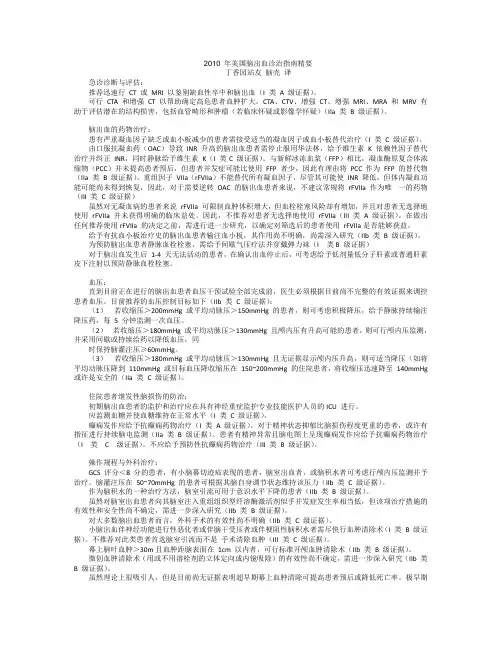
2010 年美国脑出血诊治指南精要丁香园站友脑壳译急诊诊断与评估:推荐迅速行CT 或MRI 以鉴别缺血性卒中和脑出血(I 类A 级证据)。
可行CTA 和增强CT 以帮助确定高危患者血肿扩大,CTA、CTV、增强CT、增强MRI、MRA 和MRV 有助于评估潜在的结构损害,包括血管畸形和肿瘤(若临床怀疑或影像学怀疑)(IIa 类 B 级证据)。
脑出血的药物治疗:患有严重凝血因子缺乏或血小板减少的患者需接受适当的凝血因子或血小板替代治疗(I 类 C 级证据)。
由口服抗凝血药(OAC)导致INR 升高的脑出血患者需停止服用华法林,给予维生素K 依赖性因子替代治疗并纠正INR,同时静脉给予维生素K(I 类C 级证据)。
与新鲜冰冻血浆(FFP)相比,凝血酶原复合体浓缩物(PCC)并未提高患者预后,但患者并发症可能比使用FFP 者少,因此有理由将PCC作为FFP 的替代物(IIa 类 B 级证据)。
重组因子VIIa(rFVIIa)不能替代所有凝血因子,尽管其可能使INR 降低,但体内凝血功能可能尚未得到恢复,因此,对于需要逆转OAC 的脑出血患者来说,不建议常规将rFVIIa 作为唯一的药物(III 类 C 级证据)虽然对无凝血病的患者来说rFVIIa 可限制血肿体积增大,但血栓栓塞风险却有增加,并且对患者无选择地使用rFVIIa 并未获得明确的临床益处。
因此,不推荐对患者无选择地使用rFVIIa(III 类 A 级证据)。
在做出任何推荐使用rFVIIa 的决定之前,需进行进一步研究,以确定对筛选后的患者使用rFVIIa是否能够获益。
给予有抗血小板治疗史的脑出血患者输注血小板,其作用尚不明确,尚需深入研究(IIb 类 B 级证据)。
为预防脑出血患者静脉血栓栓塞,需给予间歇气压疗法并穿戴弹力袜(I 类B 级证据)对于脑出血发生后1-4 天无法活动的患者,在确认出血停止后,可考虑给予低剂量低分子肝素或普通肝素皮下注射以预防静脉血栓栓塞。
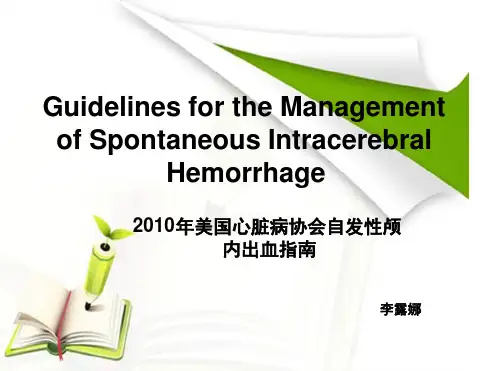
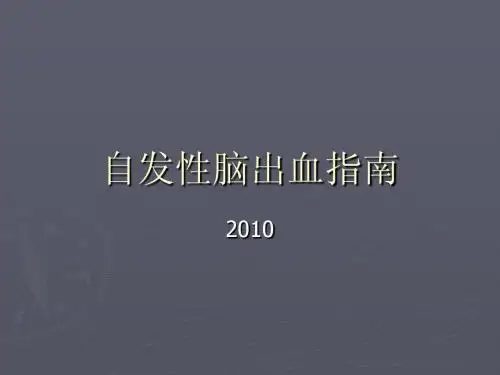

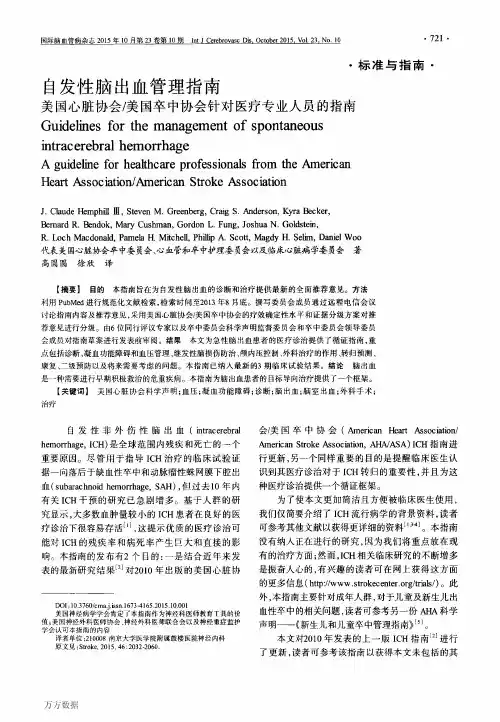
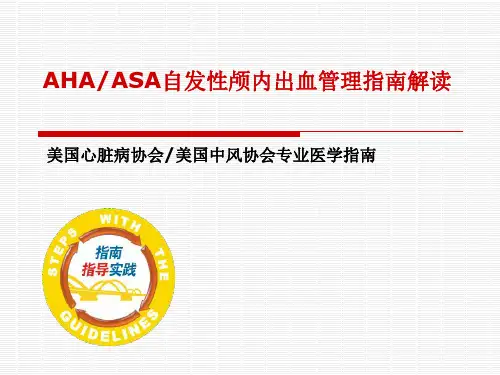
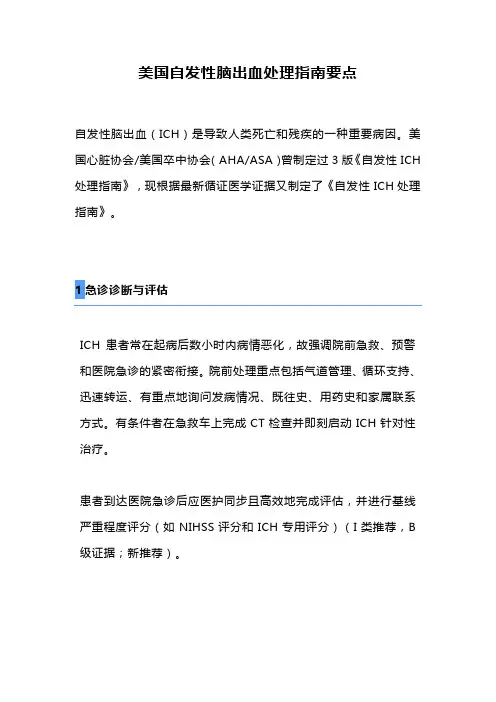
美国自发性脑出血处理指南要点自发性脑出血(ICH)是导致人类死亡和残疾的一种重要病因。
美国心脏协会/美国卒中协会(AHA/ASA)曾制定过3版《自发性ICH 处理指南》,现根据最新循证医学证据又制定了《自发性ICH处理指南》。
1急诊诊断与评估ICH患者常在起病后数小时内病情恶化,故强调院前急救、预警和医院急诊的紧密衔接。
院前处理重点包括气道管理、循环支持、迅速转运、有重点地询问发病情况、既往史、用药史和家属联系方式。
有条件者在急救车上完成CT检查并即刻启动ICH针对性治疗。
患者到达医院急诊后应医护同步且高效地完成评估,并进行基线严重程度评分(如NIHSS评分和ICH专用评分)(I类推荐,B 级证据;新推荐)。
强调神经内外科、神经影像和重症监护多学科合作,尽快将患者收入卒中单元或神经重症监护病房,尽快启动早期治疗(如降低血压和纠正凝血机制障碍)。
对急骤起病的局灶性神经系统功能障碍伴呕吐、收缩压>220mmHg、剧烈头痛、昏迷或意识程度下降以及数分钟至数几小时出现症状进展者,均应首先考虑ICH。
推荐用CT或MRI鉴别缺血性和出血性脑卒中(I类推荐,A级证据)。
CT依然是诊断急性ICH的“金标准”。
梯度回波和T2磁敏感加权MRI对识别既往出血的敏感性优于CT。
CTA和增强CT检查时血肿内高密度的造影剂(“点征”)斑点数量越多,血肿扩大的风险也越高(IIb类推荐,B级证据)。
对年龄<65岁、女性、非吸烟者、脑叶出血、破入脑室以及无高血压史或凝血功能障碍的ICH应考虑脑血管异常的可能,CTA、CTV、增强CT、增强MRI、MRA、MRV和DSA等检查有助于明确出血原因(如动静脉畸形、肿瘤、烟雾病和脑静脉血栓等)(IIa类推荐,B级证据)。
蛛网膜下腔出血、ICH边缘的血管扩张或钙化、静脉引流部位的硬脑膜静脉窦或皮层静脉内高密度影、非常见形态或常见部位的血肿、水肿范围与ICH的时间不成比例、脑内有其他结构异常(如占位病变)等影像学表现均提示可能为血管病变或肿瘤所继发的ICH。

AHA/ASA 自发性颅内出血管理指南—美国心脏病协会/ 美国中风协会专业医学指南译者:wxhsin2 美国神经病学会证实该指南适用于神经科医师培训,美国神经外科医师协会和美国神经外科医师代表大会审阅了该指南并肯定了该指南的内容。
Lewis B. Morgenstern, MD, FAHA, FAAN, Chair;J. Claude Hemphill III, MD, MAS, FAAN, Vice-Chair; Craig Anderson, MBBS, PhD, FRACP; Kyra Becker, MD; Joseph P. Broderick, MD, FAHA; E. Sander Connolly, Jr,MD, FAHA;Steven M. Greenberg, MD, PhD, FAHA, FAAN; James N. Huang, MD; R. Loch Macdonald, MD, PhD;Steven R. Mess, MD, FAHA; Pamela H. Mitchell, RN, PhD, FAHA, FAAN;Magdy Selim, MD, PhD, FAHA; Rafael J. Tamargo, MD;本指南代表美国心脏协会、中风协会及心血管护理协会的观点。
目的:本指南旨在提供目前急性自发性颅内出血的诊断和治疗建议。
方法:本指南基于MEDLINE 检索的结果,使用证据列表( evidence tables)来合成数据,写作组成员通过远程会议来讨论基于研究数据的推荐意见,并使用美国心脏协会中风分会的证据分级法则对推荐意见进行分级,本指南由 6 位审核专家及中风分会科学指南监督委员会和中风分会指导委员会全体成员审阅,并将于 3 年内完整更新。
结果:本指南旨在为颅内出血病人的管理提供基于研究数据的建议,本指南包括以下几个部分:诊断,止血方法,血压管理,住院病人护理,并发症预防,手术治疗,预后评估,康复,复发的预防及出院后注意事项。